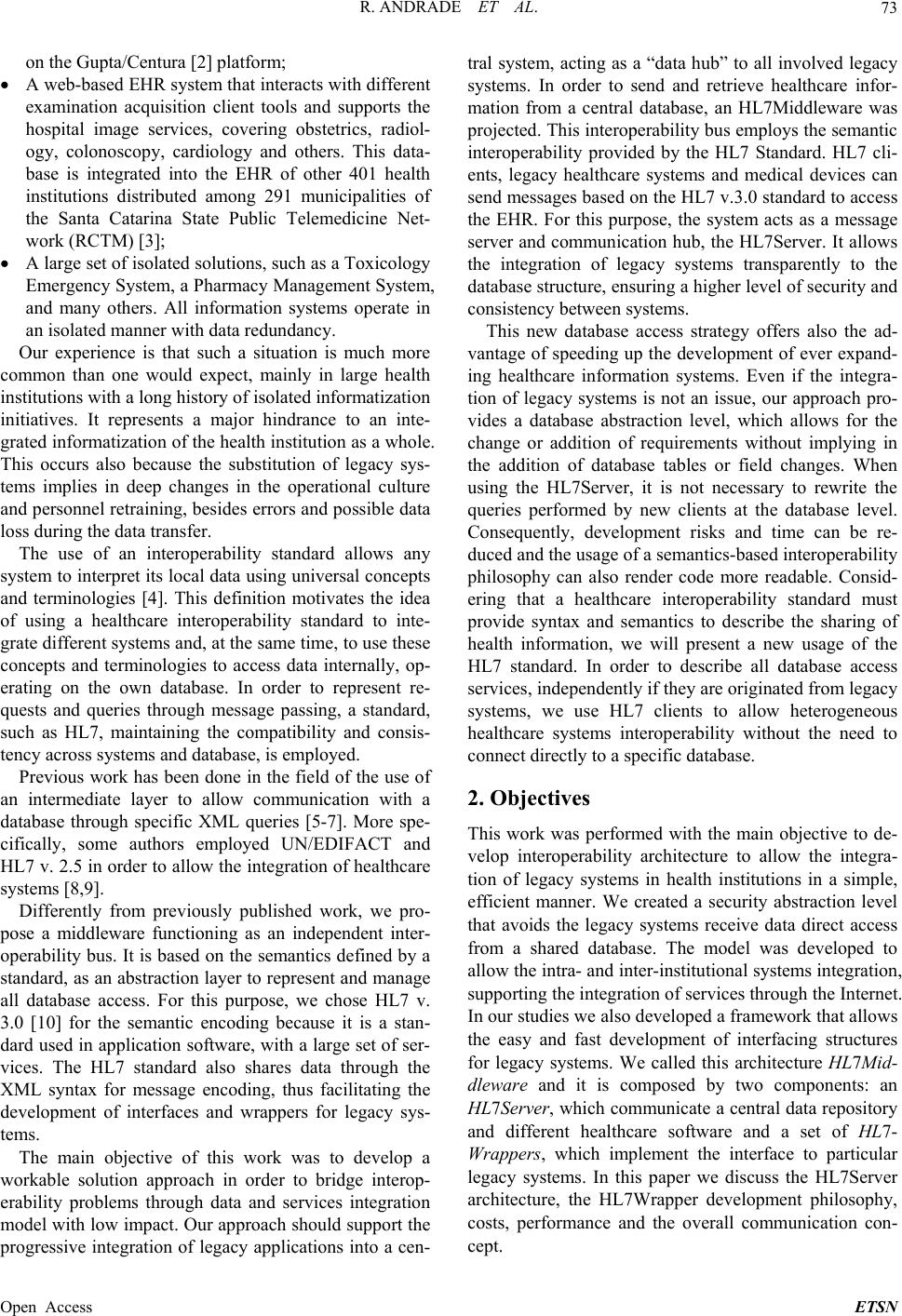
R. ANDRADE ET AL. 73
on the Gupta/Centura [2] platform;
A web-based EHR system that interacts with different
examination acquisition client tools and supports the
hospital image services, covering obstetrics, radiol-
ogy, colonoscopy, cardiology and others. This data-
base is integrated into the EHR of other 401 health
institutions distributed among 291 municipalities of
the Santa Catarina State Public Telemedicine Net-
work (RCTM) [3];
A large set of isolated solutions, such as a Toxicology
Emergency System, a Pharmacy Management System,
and many others. All information systems operate in
an isolated manner with data redundancy.
Our experience is that such a situation is much more
common than one would expect, mainly in large health
institutions with a long history of isolated informatization
initiatives. It represents a major hindrance to an inte-
grated informatization of the health institution as a whole.
This occurs also because the substitution of legacy sys-
tems implies in deep changes in the operational culture
and personnel retraining, besides errors and possible data
loss during the data transfer.
The use of an interoperability standard allows any
system to interpret its local data using universal concepts
and terminologies [4]. This definition motivates the idea
of using a healthcare interoperability standard to inte-
grate different systems and, at the same time, to use these
concepts and terminologies to access data internally, op-
erating on the own database. In order to represent re-
quests and queries through message passing, a standard,
such as HL7, maintaining the compatibility and consis-
tency across systems and database, is employed.
Previous work has been done in the field of the use of
an intermediate layer to allow communication with a
database through specific XML queries [5-7]. More spe-
cifically, some authors employed UN/EDIFACT and
HL7 v. 2.5 in order to allow the integration of healthcare
systems [8,9].
Differently from previously published work, we pro-
pose a middleware functioning as an independent inter-
operability bus. It is based on the semantics defined by a
standard, as an abstraction layer to represent and manage
all database access. For this purpose, we chose HL7 v.
3.0 [10] for the semantic encoding because it is a stan-
dard used in application software, with a large set of ser-
vices. The HL7 standard also shares data through the
XML syntax for message encoding, thus facilitating the
development of interfaces and wrappers for legacy sys-
tems.
The main objective of this work was to develop a
workable solution approach in order to bridge interop-
erability problems through data and services integration
model with low impact. Our approach should support the
progressive integration of legacy applications into a cen-
tral system, acting as a “data hub” to all involved legacy
systems. In order to send and retrieve healthcare infor-
mation from a central database, an HL7Middleware was
projected. This interoperability bus employs the semantic
interoperability provided by the HL7 Standard. HL7 cli-
ents, legacy healthcare systems and medical devices can
send messages based on the HL7 v.3.0 standard to access
the EHR. For this purpose, the system acts as a message
server and communication hub, the HL7Server. It allows
the integration of legacy systems transparently to the
database structure, ensuring a higher level of security and
consistency between systems.
This new database access strategy offers also the ad-
vantage of speeding up the development of ever expand-
ing healthcare information systems. Even if the integra-
tion of legacy systems is not an issue, our approach pro-
vides a database abstraction level, which allows for the
change or addition of requirements without implying in
the addition of database tables or field changes. When
using the HL7Server, it is not necessary to rewrite the
queries performed by new clients at the database level.
Consequently, development risks and time can be re-
duced and the usage of a semantics-based interoperability
philosophy can also render code more readable. Consid-
ering that a healthcare interoperability standard must
provide syntax and semantics to describe the sharing of
health information, we will present a new usage of the
HL7 standard. In order to describe all database access
services, independently if they are originated from legacy
systems, we use HL7 clients to allow heterogeneous
healthcare systems interoperability without the need to
connect directly to a specific database.
2. Objectives
This work was performed with the main objective to de-
velop interoperability architecture to allow the integra-
tion of legacy systems in health institutions in a simple,
efficient manner. We created a security abstraction level
that avoids the legacy systems receive data direct access
from a shared database. The model was developed to
allow the intra- and inter-institutional systems integration,
supporting the integration of services through the Internet.
In our studies we also developed a framework that allows
the easy and fast development of interfacing structures
for legacy systems. We called this architecture HL7Mid-
dleware and it is composed by two components: an
HL7Server, which communicate a central data repository
and different healthcare software and a set of HL7-
Wrappers, which implement the interface to particular
legacy systems. In this paper we discuss the HL7Server
architecture, the HL7Wrapper development philosophy,
costs, performance and the overall communication con-
cept.
Open Access ETSN